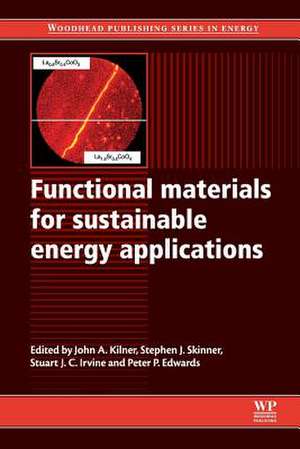Functional Materials for Sustainable Energy Applications: Woodhead Publishing Series in Energy
Editat de J A Kilner, S J Skinner, S J C Irvine, P P Edwardsen Limba Engleză Paperback – 18 aug 2016
Part one reviews functional materials for solar power, including silicon-based, thin-film, and dye sensitized photovoltaic solar cells, thermophotovoltaic device modelling and photoelectrochemical cells. Part two focuses on functional materials for hydrogen production and storage. Functional materials for fuel cells are then explored in part three where developments in membranes, catalysts and membrane electrode assemblies for polymer electrolyte and direct methanol fuel cells are discussed, alongside electrolytes and ion conductors, novel cathodes, anodes, thin films and proton conductors for solid oxide fuel cells. Part four considers functional materials for demand reduction and energy storage, before the book concludes in part five with an investigation into computer simulation studies of functional materials.
With its distinguished editors and international team of expert contributors, Functional materials for sustainable energy applications is an indispensable tool for anyone involved in the research, development, manufacture and application of materials for sustainable energy production, including materials engineers, scientists and academics in the rapidly developing, interdisciplinary field of sustainable energy.
- An essential guide to the development and application of functional materials in sustainable energy production
- Reviews functional materials for solar power
- Focuses on functional materials for hydrogen production and storage, fuel cells, demand reduction and energy storage
Din seria Woodhead Publishing Series in Energy
-
 Preț: 853.23 lei
Preț: 853.23 lei - 24%
 Preț: 1209.19 lei
Preț: 1209.19 lei - 24%
 Preț: 1307.96 lei
Preț: 1307.96 lei - 24%
 Preț: 1386.95 lei
Preț: 1386.95 lei - 9%
 Preț: 900.25 lei
Preț: 900.25 lei - 9%
 Preț: 1067.83 lei
Preț: 1067.83 lei - 29%
 Preț: 1071.46 lei
Preț: 1071.46 lei - 9%
 Preț: 950.40 lei
Preț: 950.40 lei - 9%
 Preț: 1011.50 lei
Preț: 1011.50 lei - 29%
 Preț: 1071.13 lei
Preț: 1071.13 lei - 9%
 Preț: 1309.35 lei
Preț: 1309.35 lei - 39%
 Preț: 1047.65 lei
Preț: 1047.65 lei - 9%
 Preț: 949.23 lei
Preț: 949.23 lei - 24%
 Preț: 1688.64 lei
Preț: 1688.64 lei - 9%
 Preț: 1344.70 lei
Preț: 1344.70 lei - 9%
 Preț: 1049.56 lei
Preț: 1049.56 lei - 27%
 Preț: 1937.44 lei
Preț: 1937.44 lei - 23%
 Preț: 1519.01 lei
Preț: 1519.01 lei - 23%
 Preț: 1074.68 lei
Preț: 1074.68 lei - 29%
 Preț: 981.24 lei
Preț: 981.24 lei - 9%
 Preț: 1397.24 lei
Preț: 1397.24 lei - 39%
 Preț: 1397.48 lei
Preț: 1397.48 lei - 9%
 Preț: 945.89 lei
Preț: 945.89 lei - 9%
 Preț: 1073.87 lei
Preț: 1073.87 lei - 9%
 Preț: 1514.09 lei
Preț: 1514.09 lei - 9%
 Preț: 1020.23 lei
Preț: 1020.23 lei - 39%
 Preț: 880.81 lei
Preț: 880.81 lei - 9%
 Preț: 950.94 lei
Preț: 950.94 lei - 39%
 Preț: 1225.96 lei
Preț: 1225.96 lei - 9%
 Preț: 1214.08 lei
Preț: 1214.08 lei - 39%
 Preț: 1085.98 lei
Preț: 1085.98 lei - 9%
 Preț: 868.43 lei
Preț: 868.43 lei - 24%
 Preț: 1615.93 lei
Preț: 1615.93 lei - 31%
 Preț: 927.68 lei
Preț: 927.68 lei - 24%
 Preț: 1077.86 lei
Preț: 1077.86 lei - 9%
 Preț: 946.04 lei
Preț: 946.04 lei - 9%
 Preț: 952.05 lei
Preț: 952.05 lei - 9%
 Preț: 1165.33 lei
Preț: 1165.33 lei - 24%
 Preț: 1307.96 lei
Preț: 1307.96 lei - 29%
 Preț: 1213.47 lei
Preț: 1213.47 lei - 24%
 Preț: 1075.25 lei
Preț: 1075.25 lei - 24%
 Preț: 1048.44 lei
Preț: 1048.44 lei - 29%
 Preț: 1454.22 lei
Preț: 1454.22 lei - 39%
 Preț: 1285.27 lei
Preț: 1285.27 lei - 9%
 Preț: 952.68 lei
Preț: 952.68 lei - 23%
 Preț: 878.04 lei
Preț: 878.04 lei - 9%
 Preț: 951.98 lei
Preț: 951.98 lei - 9%
 Preț: 1209.42 lei
Preț: 1209.42 lei
Preț: 1233.82 lei
Preț vechi: 1355.85 lei
-9% Nou
Puncte Express: 1851
Preț estimativ în valută:
236.12€ • 245.60$ • 194.93£
236.12€ • 245.60$ • 194.93£
Carte tipărită la comandă
Livrare economică 07-21 aprilie
Preluare comenzi: 021 569.72.76
Specificații
ISBN-13: 9780081016213
ISBN-10: 0081016212
Pagini: 708
Dimensiuni: 156 x 234 x 36 mm
Greutate: 0.98 kg
Editura: ELSEVIER SCIENCE
Seria Woodhead Publishing Series in Energy
ISBN-10: 0081016212
Pagini: 708
Dimensiuni: 156 x 234 x 36 mm
Greutate: 0.98 kg
Editura: ELSEVIER SCIENCE
Seria Woodhead Publishing Series in Energy
Cuprins
Contributor contact details
Woodhead Publishing Series in Energy
Preface
Part I: Functional materials for solar power
Chapter 1: Silicon-based photovoltaic solar cells
Abstract:
1.1 Introduction
1.2 Polysilicon production
1.3 Crystallisation and wafering
1.4 Solar cells: materials issues and cell architectures
1.5 Conclusions
Chapter 2: Photovoltaic (PV) thin-films for solar cells
Abstract:
2.1 Introduction
2.2 Amorphous silicon thin-film photovoltaic (PV)
2.3 Cadmium telluride thin-film PV
2.4 Copper indium diselenide thin-film PV
2.5 Materials sustainability
2.6 Future trends
2.7 Sources of further information and advice
Chapter 3: Rapid, low-temperature processing of dye-sensitized solar cells
Abstract:
3.1 Introduction to dye-sensitized solar cells (DSCs)
3.2 Manufacturing issues
3.3 Sensitization
3.4 Electrodes
3.5 Electrolyte
3.6 Quality control (QC)/lifetime testing
3.7 Conclusions and future trends
3.8 Acknowledgements
Chapter 4: Thermophotovoltaic (TPV) devices: introduction and modelling
Abstract:
4.1 Introduction to thermophotovoltaics (TPVs)
4.2 Practical TPV cell performance
4.3 Modelling TPV cells
4.4 Tandem TPV cells
4.5 Conclusions
Chapter 5: Photoelectrochemical cells for hydrogen generation
Abstract:
5.1 Introduction
5.2 Photoelectrochemical cells: principles and energetics
5.3 Photoelectrochemical cell configurations and efficiency considerations
5.4 Semiconductor photoanodes: material challenges
5.5 Semiconductor photocathodes: material challenges
5.6 Advances in photochemical cell materials and design
5.7 Interfacial reaction kinetics
5.8 Future trends
5.9 Acknowledgements
5.11 Appendix: abbreviations
Part II: Functional materials for hydrogen production and storage
Chapter 6: Reversible solid oxide electrolytic cells for large-scale energy storage: challenges and opportunities
Abstract:
6.1 Introduction to reversible solid oxide cells
6.2 Operating principles and functional materials
6.3 Degradation mechanisms in solid oxide electrolysis cells
6.4 Research needs and opportunities
6.5 Summary and conclusions
Chapter 7: Membranes, adsorbent materials and solvent-based materials for syngas and hydrogen separation
Abstract:
7.1 Introduction
7.2 H2-selective membrane materials
7.3 CO2-selective membrane materials
7.4 Adsorbent materials for H2/CO2 separation
7.5 Solvent-based materials for H2/CO2 separation
7.6 Future trends
7.7 Sources of further information and advice
Chapter 8: Functional materials for hydrogen storage
Abstract:
8.1 Introduction
8.2 Hydrogen storage with metal hydrides: an introduction
8.3 Hydrogen storage with interstitial hydrides, AlH3 and MgH2
8.4 Hydrogen storage with complex metal hydrides
8.5 Hydrogen storage using other chemical systems
8.6 Hydrogen storage with porous materials and nanoconfined materials
8.7 Applications of hydrogen storage
8.8 Conclusions
Part III: Functional materials for fuel cells
Chapter 9: The role of the fuel in the operation, performance and degradation of fuel cells
Abstract:
9.1 Introduction
9.2 Thermodynamics of fuel cell operation and the effect of fuel on performance
9.3 Hydrocarbon fuels and fuel processing
9.4 Methanol
9.5 Other fuels
9.6 Deleterious effects of fuels on fuel cell performance
9.7 Conclusions
9.8 Acknowledgements
Chapter 10: Membrane electrode assemblies for polymer electrolyte membrane fuel cells
Abstract:
10.1 Introduction
10.2 Requirements for membrane electrode assemblies (MEAs)
10.3 Porous backing layer materials
10.4 Membrane materials
10.5 MEA electrode catalyst layer
10.6 MEA performance
10.7 Conclusions
Chapter 11: Developments in membranes, catalysts and membrane electrode assemblies for direct methanol fuel cells (DMFCs)
Abstract:
11.1 Introduction
11.2 Historica! development and technical challenges
11.3 Methanol oxidation reaction catalysts
11.4 Oxygen reduction reaction (ORR) catalysts
11.5 Proton exchange membranes
11.6 Membrane electrode assembly (MEA) fabrication and structure
11.7 Conclusions and future trends
11.8 Acknowledgements
Chapter 12: Electrolytes and ion conductors for solid oxide fuel cells (SOFCs)
Abstract:
12.1 Introduction
12.2 Oxide ion conduction
12.3 Electrolyte materials for solid oxide fuel cells (SOFCs)
12.4 Preparation and characterization of electrolyte materials for SOFCs
12.5 Conclusions
Chapter 13: Novel cathodes for solid oxide fuel cells
Abstract:
13.1 Introduction
13.2 The oxygen reduction reaction in solid oxide fuel cells (SOFCs) and implications for cathode materials
13.3 Conventional cathode materials: perovskitetype oxides
13.4 Innovative cathode materials: structural aspects of 2D non-stoichiometric perovskite-related oxides
13.5 Comparative transport properties and electrochemical performances of 2D non-stoichiometric oxides
13.6 Ln2NiO4 + δ oxides: innovative and flexible materials for air electrodes of protonic ceramic fuel cells (PCFCs) and electrolyzers
13.7 Prospective conclusions
Chapter 14: Novel anode materials for solid oxide fuel cells
Abstract:
14.1 Introduction
14.2 Requirements for solid oxide fuel cell anode materials
14.3 Cermet solid oxide fuel cell anode materials
14.4 Perovskite-structured solid oxide fuel cell anode materials
14.5 Other oxide anode materials
14.6 Non-oxide anode materials
14.7 Poisoning of solid oxide fuel cell anode materials
14.8 Conclusions and future trends
Chapter 15: Thin-film solid oxide fuel cell (SOFC) materials
Abstract:
15.1 Introduction
15.2 Electrolytes
15.3 Anode materials
15.4 Cathode materials
15.5 Device structures
15.6 Conclusions
15.7 Acknowledgments
15.9 Appendix: glossary
Chapter 16: Proton conductors for solid oxide fuel cells (SOFCs)
Abstract:
16.1 The proton conduction mechanism in high-temperature proton conductor (HTPC) electrolytes
16.2 Reaction processes at the electrode/electrolyte when using HTPC electrolytes
16.3 HTPC: the state of the art and challenges
16.4 Electrodes for HTPC electrolytes: the state of the art and challenges
16.5 Solid oxide fuel cells (SOFCs) based on HTPC electrolytes: current status and future perspectives
16.6 Conclusions
Part IV: Functional materials for demand reduction and energy storage
Chapter 17: Materials and techniques for energy harvesting
Abstract:
17.1 Introduction
17.2 Theory of motion energy harvesting
17.3 Piezoelectric harvesting
17.4 Electrostatic harvesting
17.5 Thermoelectric harvesting
17.6 Electromagnetic energy harvesting from motion
17.7 Suspension materials for motion energy harvesting
Chapter 18: Lithium batteries: current technologies and future trends
Abstract:
18.1 Introduction
18.2 Lithium-ion batteries
18.3 Safety of lithium-ion batteries
18.4 Energy density of lithium-ion batteries
18.5 Future trends
18.6 Acknowledgements
Chapter 19: Rare-earth magnets: properties, processing and applications
Abstract:
19.1 Introduction
19.2 Properties of permanent magnetic materials
19.3 Improving the properties of permanent magnetic materials
19.4 Processing of permanent magnets
19.5 Properties of commercially manufactured permanent magnets
19.6 Applications of permanent magnet materials
Part V: Appendix
Atomic-scale computer simulation of functional materials: methodologies and applications
Index
Woodhead Publishing Series in Energy
Preface
Part I: Functional materials for solar power
Chapter 1: Silicon-based photovoltaic solar cells
Abstract:
1.1 Introduction
1.2 Polysilicon production
1.3 Crystallisation and wafering
1.4 Solar cells: materials issues and cell architectures
1.5 Conclusions
Chapter 2: Photovoltaic (PV) thin-films for solar cells
Abstract:
2.1 Introduction
2.2 Amorphous silicon thin-film photovoltaic (PV)
2.3 Cadmium telluride thin-film PV
2.4 Copper indium diselenide thin-film PV
2.5 Materials sustainability
2.6 Future trends
2.7 Sources of further information and advice
Chapter 3: Rapid, low-temperature processing of dye-sensitized solar cells
Abstract:
3.1 Introduction to dye-sensitized solar cells (DSCs)
3.2 Manufacturing issues
3.3 Sensitization
3.4 Electrodes
3.5 Electrolyte
3.6 Quality control (QC)/lifetime testing
3.7 Conclusions and future trends
3.8 Acknowledgements
Chapter 4: Thermophotovoltaic (TPV) devices: introduction and modelling
Abstract:
4.1 Introduction to thermophotovoltaics (TPVs)
4.2 Practical TPV cell performance
4.3 Modelling TPV cells
4.4 Tandem TPV cells
4.5 Conclusions
Chapter 5: Photoelectrochemical cells for hydrogen generation
Abstract:
5.1 Introduction
5.2 Photoelectrochemical cells: principles and energetics
5.3 Photoelectrochemical cell configurations and efficiency considerations
5.4 Semiconductor photoanodes: material challenges
5.5 Semiconductor photocathodes: material challenges
5.6 Advances in photochemical cell materials and design
5.7 Interfacial reaction kinetics
5.8 Future trends
5.9 Acknowledgements
5.11 Appendix: abbreviations
Part II: Functional materials for hydrogen production and storage
Chapter 6: Reversible solid oxide electrolytic cells for large-scale energy storage: challenges and opportunities
Abstract:
6.1 Introduction to reversible solid oxide cells
6.2 Operating principles and functional materials
6.3 Degradation mechanisms in solid oxide electrolysis cells
6.4 Research needs and opportunities
6.5 Summary and conclusions
Chapter 7: Membranes, adsorbent materials and solvent-based materials for syngas and hydrogen separation
Abstract:
7.1 Introduction
7.2 H2-selective membrane materials
7.3 CO2-selective membrane materials
7.4 Adsorbent materials for H2/CO2 separation
7.5 Solvent-based materials for H2/CO2 separation
7.6 Future trends
7.7 Sources of further information and advice
Chapter 8: Functional materials for hydrogen storage
Abstract:
8.1 Introduction
8.2 Hydrogen storage with metal hydrides: an introduction
8.3 Hydrogen storage with interstitial hydrides, AlH3 and MgH2
8.4 Hydrogen storage with complex metal hydrides
8.5 Hydrogen storage using other chemical systems
8.6 Hydrogen storage with porous materials and nanoconfined materials
8.7 Applications of hydrogen storage
8.8 Conclusions
Part III: Functional materials for fuel cells
Chapter 9: The role of the fuel in the operation, performance and degradation of fuel cells
Abstract:
9.1 Introduction
9.2 Thermodynamics of fuel cell operation and the effect of fuel on performance
9.3 Hydrocarbon fuels and fuel processing
9.4 Methanol
9.5 Other fuels
9.6 Deleterious effects of fuels on fuel cell performance
9.7 Conclusions
9.8 Acknowledgements
Chapter 10: Membrane electrode assemblies for polymer electrolyte membrane fuel cells
Abstract:
10.1 Introduction
10.2 Requirements for membrane electrode assemblies (MEAs)
10.3 Porous backing layer materials
10.4 Membrane materials
10.5 MEA electrode catalyst layer
10.6 MEA performance
10.7 Conclusions
Chapter 11: Developments in membranes, catalysts and membrane electrode assemblies for direct methanol fuel cells (DMFCs)
Abstract:
11.1 Introduction
11.2 Historica! development and technical challenges
11.3 Methanol oxidation reaction catalysts
11.4 Oxygen reduction reaction (ORR) catalysts
11.5 Proton exchange membranes
11.6 Membrane electrode assembly (MEA) fabrication and structure
11.7 Conclusions and future trends
11.8 Acknowledgements
Chapter 12: Electrolytes and ion conductors for solid oxide fuel cells (SOFCs)
Abstract:
12.1 Introduction
12.2 Oxide ion conduction
12.3 Electrolyte materials for solid oxide fuel cells (SOFCs)
12.4 Preparation and characterization of electrolyte materials for SOFCs
12.5 Conclusions
Chapter 13: Novel cathodes for solid oxide fuel cells
Abstract:
13.1 Introduction
13.2 The oxygen reduction reaction in solid oxide fuel cells (SOFCs) and implications for cathode materials
13.3 Conventional cathode materials: perovskitetype oxides
13.4 Innovative cathode materials: structural aspects of 2D non-stoichiometric perovskite-related oxides
13.5 Comparative transport properties and electrochemical performances of 2D non-stoichiometric oxides
13.6 Ln2NiO4 + δ oxides: innovative and flexible materials for air electrodes of protonic ceramic fuel cells (PCFCs) and electrolyzers
13.7 Prospective conclusions
Chapter 14: Novel anode materials for solid oxide fuel cells
Abstract:
14.1 Introduction
14.2 Requirements for solid oxide fuel cell anode materials
14.3 Cermet solid oxide fuel cell anode materials
14.4 Perovskite-structured solid oxide fuel cell anode materials
14.5 Other oxide anode materials
14.6 Non-oxide anode materials
14.7 Poisoning of solid oxide fuel cell anode materials
14.8 Conclusions and future trends
Chapter 15: Thin-film solid oxide fuel cell (SOFC) materials
Abstract:
15.1 Introduction
15.2 Electrolytes
15.3 Anode materials
15.4 Cathode materials
15.5 Device structures
15.6 Conclusions
15.7 Acknowledgments
15.9 Appendix: glossary
Chapter 16: Proton conductors for solid oxide fuel cells (SOFCs)
Abstract:
16.1 The proton conduction mechanism in high-temperature proton conductor (HTPC) electrolytes
16.2 Reaction processes at the electrode/electrolyte when using HTPC electrolytes
16.3 HTPC: the state of the art and challenges
16.4 Electrodes for HTPC electrolytes: the state of the art and challenges
16.5 Solid oxide fuel cells (SOFCs) based on HTPC electrolytes: current status and future perspectives
16.6 Conclusions
Part IV: Functional materials for demand reduction and energy storage
Chapter 17: Materials and techniques for energy harvesting
Abstract:
17.1 Introduction
17.2 Theory of motion energy harvesting
17.3 Piezoelectric harvesting
17.4 Electrostatic harvesting
17.5 Thermoelectric harvesting
17.6 Electromagnetic energy harvesting from motion
17.7 Suspension materials for motion energy harvesting
Chapter 18: Lithium batteries: current technologies and future trends
Abstract:
18.1 Introduction
18.2 Lithium-ion batteries
18.3 Safety of lithium-ion batteries
18.4 Energy density of lithium-ion batteries
18.5 Future trends
18.6 Acknowledgements
Chapter 19: Rare-earth magnets: properties, processing and applications
Abstract:
19.1 Introduction
19.2 Properties of permanent magnetic materials
19.3 Improving the properties of permanent magnetic materials
19.4 Processing of permanent magnets
19.5 Properties of commercially manufactured permanent magnets
19.6 Applications of permanent magnet materials
Part V: Appendix
Atomic-scale computer simulation of functional materials: methodologies and applications
Index







